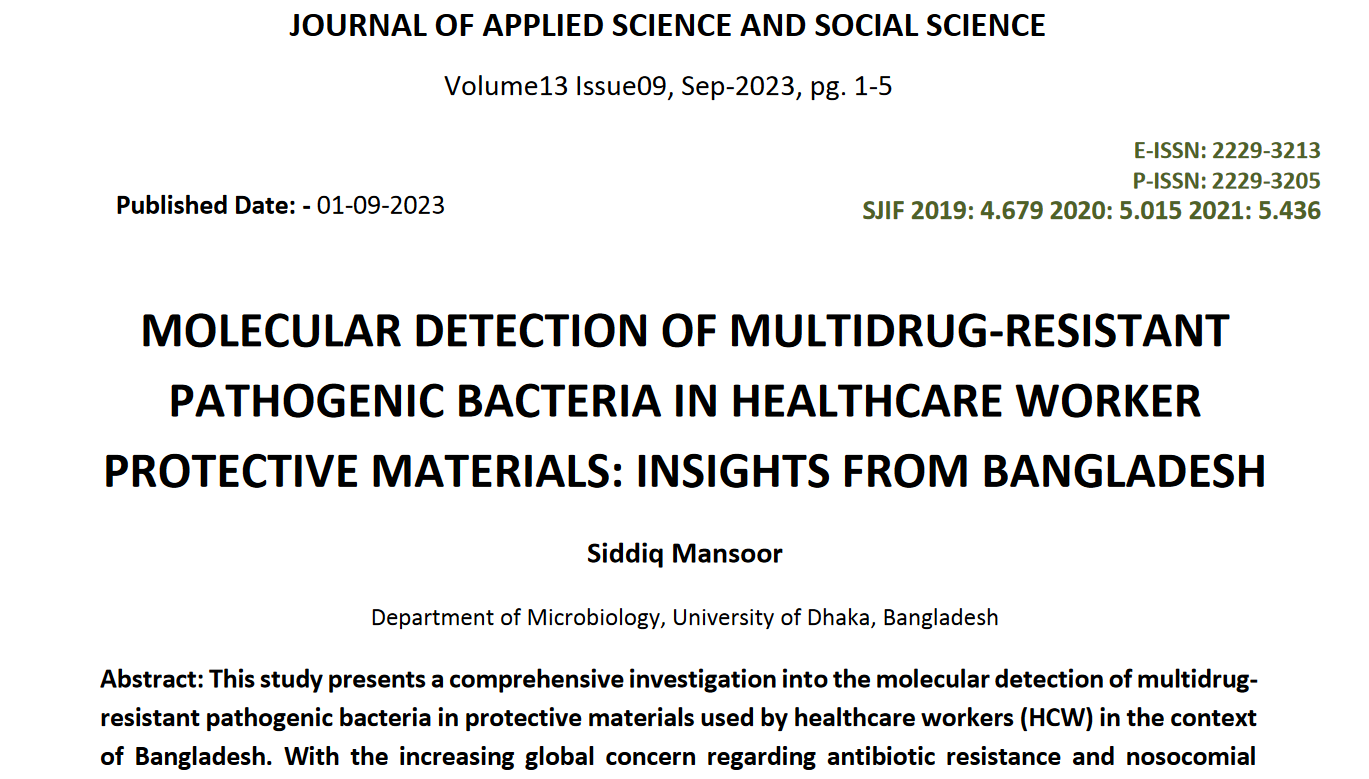MOLECULAR DETECTION OF MULTIDRUG-RESISTANT PATHOGENIC BACTERIA IN HEALTHCARE WORKER PROTECTIVE MATERIALS: INSIGHTS FROM BANGLADESH
Keywords:
Molecular Detection, Multidrug Resistance, Pathogenic BacteriaAbstract
This study presents a comprehensive investigation into the molecular detection of multidrug-resistant pathogenic bacteria in protective materials used by healthcare workers (HCW) in the context of Bangladesh. With the increasing global concern regarding antibiotic resistance and nosocomial infections, this research sheds light on the presence and prevalence of multidrug-resistant pathogens in HCW protective gear. Employing advanced molecular techniques, we analyze samples from a range of protective materials, providing valuable insights into the potential risks faced by HCWs and the implications for infection control practices in healthcare settings in Bangladesh.
Downloads
References
Rocha,I. V.,Ferraz,P. D. M., Farias,T.G. S.D.,& Oliveira,S.R.D, 2015. Resistance of bacteria isolated from equipment in an intensive careunit. Acta Paulista de Enfermagem., 28(5):433-439.
Islam, T., O. Saha, S. Sultana, M. Hridoy, M. Hasan, S. Marzan and M.M. Rahman, 2017. Comparison between reduced susceptibility to disinfectants and multidrug resistance among hospital isolates of Pseudomonas aeruginosa and Staphylococcus aureus in Bangladesh. Bagcilar Med. Bull., 2: 88-97.
Hidron, A.I., J.R. Edwards, J. Patel, T.C. Horan and D.M. Sievertet al., 2008. NHSN annual update: Antimicrobial-resistant pathogens associated with healthcare-associated infections: Annual summary of data reported to the National Healthcare Safety Network at the Centers for Disease Control and Prevention, 2006-2007. Infect. Control Hosp. Epidemiol., 29: 996-1011.
Fazeli, N. and H. Momtaz, 2014. Virulence gene profiles of multidrug-resistant Pseudomonas aeruginosa isolated from Iranian hospital infections. Iran. Red Crescent Med. J., Vol. 16, No. 10. 10.5812/ircmj.15722.
Brady, R.R., S.F. Fraser, M.G. Dunlop, S. Paterson-Brown and A.P. Gibb, 2007. Bacterial contamination of mobile communication devices in the operative environment. J. Hospital Infect., 66: 397-398.
Ducel, G., J. Fabry and L. Nicolle, 2002. Prevention of Hospital Acquired Infections: A Practical Guide. 2nd Edn., World Health Organization, Geneva, Switzerland, Pages: 64.
Pal, S., D. Juyal, S. Adekhandi, M. Sharma and R. Prakash et al., 2015. Mobile phones: Reservoirs for the transmission of nosocomial pathogens. Adv. Biomed., Res., Vol. 4. 10.4103/2277-9175.161553.
Diaz, M.H., C. Silkaitis, M. Malczynski, G. Noskin, J. Warren and T. Zembower, 2008. Contamination of examination gloves in patient rooms and implications for transmission of antimicrobial-resistant microorganisms. Infect. Control Hosp. Epidemiol., 29: 63-65.
CDC., 2003. Guidelines for environmental infection control in health-care facilities. Healthcare Infection Control Advisory Committee, Centers for Disease Control and Prevention, Atlanta. https://www.cdc.gov/infectioncontrol/pdf/ guidelines/environmental-guidelines.pdf
Lee, T.B., O.G. Baker, J.T. Lee, W.E. Scheckler, L. Steele and C.E. Laxton, 1998. Recommended practices for surveillance. Am. J. Infect. Control, 26: 277-288.

Downloads
Published
How to Cite
Issue
Section
License
Copyright (c) 2023 Siddiq Mansoor

This work is licensed under a Creative Commons Attribution-NonCommercial 4.0 International License.
All content published in the Journal of Applied Science and Social Science (JASSS) is protected by copyright. Authors retain the copyright to their work, and grant JASSS the right to publish the work under a Creative Commons Attribution License (CC BY). This license allows others to distribute, remix, adapt, and build upon the work, even commercially, as long as they credit the author(s) for the original creation.

